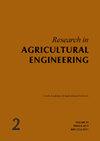Kitchen cooking by electroporation
Q3 Agricultural and Biological Sciences
引用次数: 0
Abstract
Recently, modern non-heating-based food processing alternatives have emerged. The pulsed electric field (PEF) technology is an example, which does not require high temperatures and, in principle, preserves both the nutritional and functional characteristics of the food while possibly improving the taste. Nevertheless, using this technology in kitchen conditions is still a challenge. Thus, the main aim of this work was the development of a kitchen cooking device that uses pure pulse electroporation (without thermal effects). A device powered by a common electrical network was designed. The voltage applied to the electrodes is approximately 150 V. At a food thickness of 3 mm, an intensity of 500 V·cm–1 was achieved, which was sufficient for the electroporation of typical vegetables. Depending on the specific food being treated, the device repeats the pulses until the required degree of the PEF treatment is reached. Preparing a larger amount of food at one time would require great instant power from the device. In order to load the device with less current, the large working area of the electrodes was divided into nine segments. The food is gradually prepared segment by segment. The function of the device is controlled via an electronic programmable control unit. The electroporation of the processed material was achieved with a functional prototype of the designed device, but with some limitations that have to be respected in further development.厨房电穿孔烹饪
最近,现代非加热食品加工替代品已经出现。脉冲电场(PEF)技术就是一个例子,它不需要高温,原则上,在可能改善味道的同时,保留了食物的营养和功能特征。然而,在厨房条件下使用这项技术仍然是一个挑战。因此,这项工作的主要目的是开发一种使用纯脉冲电穿孔(没有热效应)的厨房烹饪装置。设计了一种由普通电网供电的装置。施加在电极上的电压约为150伏。在食物厚度为3 mm时,电穿孔强度可达500 V·cm-1,足以实现典型蔬菜的电穿孔。根据所处理的特定食品,该装置重复脉冲,直到达到所需的PEF处理程度。一次准备更多的食物需要巨大的瞬时能量。为了以较小的电流加载器件,将电极的大工作区域划分为9段。食物是一段一段地逐渐准备好的。该装置的功能通过电子可编程控制单元进行控制。加工材料的电穿孔是通过设计设备的功能原型实现的,但在进一步的开发中必须考虑到一些限制。
本文章由计算机程序翻译,如有差异,请以英文原文为准。
求助全文
约1分钟内获得全文
求助全文
来源期刊

Research in Agricultural Engineering
Engineering, agriculture-
CiteScore
1.40
自引率
0.00%
发文量
21
审稿时长
24 weeks
期刊介绍:
Original scientific papers, short communications, information, and studies covering all areas of agricultural engineering, agricultural technology, processing of agricultural products, countryside buildings and related problems from ecology, energetics, economy, ergonomy and applied physics and chemistry. Papers are published in English.
 求助内容:
求助内容: 应助结果提醒方式:
应助结果提醒方式:


